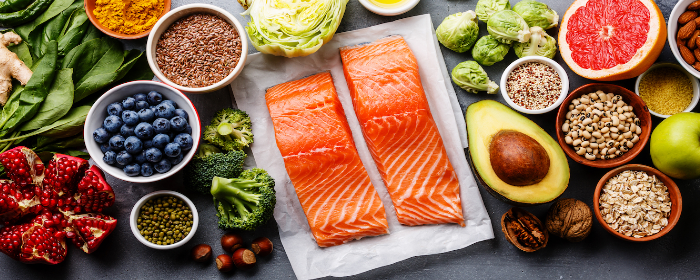
by admin | Apr 6, 2022 | Health Awareness
Most people understand what collagen is, but many are not yet familiar with liposomal vitamin C. Both of these substances are beneficial for improving gut health and reducing the inflammation that can cause stiff, swollen joints.
Benefits of Collagen
Collagen is a protein found naturally in the human body. In fact, it is the most abundant protein in the body. It is located in the musculoskeletal system, in blood vessels, and also in the digestive system.
It is often thought of as the “glue” that holds the body together. Even before the age of 30, most people have started losing their collagen stores. By 40, it is depleting more quickly than we can produce it.
Though it is mostly known for keeping skin youthful, collagen is vital in maintaining a healthy digestive system. It helps repair leaky gut by sealing the intestines and protecting them from toxins in the digestive tract.
Collagen is necessary to “heal, seal, and repair” the gut lining and return the digestive system to its natural balance.
Benefits of Liposomal Vitamin C
Liposomes are “nano-sized” transporters. They are responsible for carrying nutrients directly from the blood to the body’s cells. Liposomal vitamin C is a type of vitamin C that is more easily absorbed by the body. Microscopic droplets of fat-soluble liposomes encapsulate the vitamin C, making it easier to transport and access.
Nearly 80% of water-soluble vitamin C is excreted from the body, but almost 90% of liposomal vitamin C is directly absorbed into the digestive tract cells.
Liposomal vitamin C is easier on the gut and may help reduce the GI symptoms related to taking high doses of water-soluble vitamin C. Vitamin C is an important supplement for reducing inflammatory markers. It has effectively reduced the inflammatory symptoms associated with colds, flu, and seasonal allergies.
For more health awareness blogs, please visit www.stemedix.com/blog.

by admin | Mar 16, 2022 | Health Awareness, Multiple Sclerosis
What if there was one simple thing Multiple Sclerosis (MS) patients could do every day to increase energy levels, reduce fatigue, and help prevent the chance of injury from falls?
Great news—there are simple exercises you can do at home without expensive gym memberships or special equipment. Try these stretching, strengthening, and balance moves to help improve your overall wellness.
Marching in Place for Balance
Stand with your feet about hip-width apart. Contract your abdominal muscles, and slowly bring one knee off the floor in a marching position. Lift the thigh parallel to the floor if you can.
Pause for a count of three, and slowly lower the leg. Repeat on the other side. Continue for five repetitions, working your way up to 10–15 repetitions.
Wall Push-Ups for Stretching and Upper-Body Strength
Stand or sit facing a wall, approximately two feet away, with your feet together. Place both palms flat on the wall with arms straight at shoulder height, slightly wider than shoulder-width apart.
Lean in, keeping elbows tucked to your sides. Bring your nose close to the wall, and feel the gentle stretching in your calves and chest. Hold for one breath, checking to make sure your back is straight.
Slowly return to the starting position. Repeat three times, building to as many repetitions as you can.
Single-Leg Pose for Balance
Do this exercise while holding onto a chair or table for stability, especially if you have problems with balance or are receiving treatment for a neurodegenerative condition.
Stand with your feet shoulder-width apart. Lift your arms parallel to the floor, keeping one hand on a stable surface. Straighten one leg in front of you with your heel a few inches off the floor.
Hold and balance for up to 30 seconds. Lower your foot back to the ground. Repeat on both legs for three repetitions.
Over Head Press for Upper-Body Strength
Use lightweight dumbbells for this exercise. If you don’t have weights, try using soup cans or full water bottles.
Holding your weights, stand (or sit) with a straight posture, arms out to your sides, and bent upward with your hands at ear height. Stretch your arms up, keeping your back straight and lifting the dumbbells over your head. Your biceps should be close to your ears. Return to the starting position. Repeat ten times.
For more health awareness blogs, please visit www.stemedix.com/blog.

by Stemedix | Feb 14, 2022 | Pain Management
For decades, the treatment guidelines for pain were rest and inactivity. In contrast, more recent data shows that exercise may reduce the severity of chronic pain and offer well-established benefits, like improved physical and mental health. Some activities can benefit chronic pain patients, while others can exacerbate pain symptoms. No matter what exercise regimen you choose to manage your pain, start slowly, take breaks, and stop if your pain worsens. Here we will overview exercises for pain management.
Walking
Walking is a low-impact cardiovascular exercise that can increase strength, endurance, and heart health. If walking is challenging for you, start slow, and work your way up to walking for 30 minutes, three to five times per week.
Walking increases blood circulation, bringing oxygen to muscles and relieving stiffness. If you use a walker or a cane, bring it with you for support.
Swimming or Water Aerobics
Exercising in water also provides low-impact cardiovascular benefits without creating much stress on your joints and muscles. In addition, patients suffering from mobility issues may find extra comfort in the water, as the feeling of weightlessness may provide relief.
Swimming has the potential to build stronger muscles in the back, shoulders, legs, and core while causing minimal impact to your spine. Additionally, swimming can improve coordination, balance, and posture, which may lessen the risk of further injury.
Cycling
Cycling can strengthen your heart and lungs and improve muscle function. Compared to high-impact exercises, cycling tends to produce less stress on your weight-bearing joints, like your hips, knees, and feet. It also can reduce pain and stiffness by lubricating your joints through movement.
Patients who need to work at lower intensities can go slower, coast occasionally, and use lower gears. No matter your intensity level, research shows that the benefits of cycling remain.
Yoga
Yoga is one of few activities that focus on mental and physical fitness. In addition to using movements to stretch and strengthen muscles, yoga’s holistic approach incorporates breathing exercises and meditation.
You can modify yoga poses to accommodate your level of strength, flexibility, and physical limitations. Options include:
- Chair yoga
- Using a wall for balance
- Using yoga props to make poses more accessible
Ask your instructor about your specific challenges so that they can offer appropriate modifications. Know that some soreness a day or two after an unfamiliar workout is normal and means your muscles are reacting appropriately to exercise.
Whenever you incorporate new exercises for pain management into your routine, it’s best to discuss your plans with your healthcare provider. For more health awareness blogs, please visit www.stemedix.com/blog.

by admin | Jan 12, 2022 | Health Awareness
Taking care of your immune system may be the most important thing you can do to stay healthy and feel younger. Add these eight superfoods to your diet to help you meet your wellness goals naturally.
1. Garlic
Garlic is a prebiotic that contains allicin, a bioactive shown to increase disease-fighting cells and immune system T cells. One study also found that taking aged garlic extract supplements could help reduce cold and flu symptoms.
2. Mushrooms
Mushrooms are packed with an important soluble fiber known as beta-glucan. Beta-glucan stimulates the immune system and defends against many types of fungal and bacterial infections, parasites, and viruses.
3. Yogurt
Yogurt provides the healthy probiotic bacteria your gut needs to stay healthy. Some research suggests probiotics may even help reduce the length and severity of common cold symptoms.
4. Salmon
You already know the omega-3 fatty acids in salmon are good for your heart, but you may not have realized salmon is also a good source of vitamin D. Vitamin D may help lower your chances of developing an upper respiratory infection.
5. Kiwi
It’s strange, it’s fuzzy, it’s green, and it’s also packed with vitamin C. Kiwi is one of the few non-citrus foods that can deliver big doses of vitamin C, which is vital for maintaining the production of white blood cells and fighting off disease pathogens.
6. Tea
If you need a reason to curl up with a book and a steaming cup of tea, keeping your immune system strong is the perfect excuse. Drink five to six cups of black, green, or herbal tea to boost immune activity. You get bonus antimicrobial points by adding honey to your mug.
7. Beans and Lentils
Eat more beans and lentils if you want to live longer. In the “blue zones” (areas of the world where people live longest), legumes are a staple. Beans and lentils are high in zinc, a mineral that boosts white blood cell production as well as providing microbial protection.
8. Blueberries
Blueberries are rich in flavonoids which contain several immune-boosting properties. The flavonoids specific to blueberries may decrease the incidence and severity of infections in the upper respiratory tract as well as help fight aging naturally.
For more health awareness blogs, please visit www.stemedix.com/blog.

by admin | Nov 17, 2021 | Health Awareness
According to new research, oxidative stress is now emerging as a potential factor in many of the more than 600 neurodegenerative diseases recognized today.
What Is Oxidative Stress?
Your body needs both free radicals and antioxidants. Oxidative stress occurs when there is an imbalance in the number of free radicals and antioxidants in your body. Essentially, it is when you have too many free radicals, which can have adverse effects.
What Are Free Radicals?
Natural metabolic processes create the free radicals in your body. They are molecules with one or more unpaired electrons, which make them reactive. Free radicals quickly react with other molecules and can set off large chains of chemical reactions in your body. They are unstable and can cause damage to cells all over your body and speed up the aging process.
Free radicals are not just found in the human body. You can also find these oxygen-containing molecules in cigarette smoke, fried foods, alcohol, and pesticides.
How Does Oxidative Stress Affect the Body?
Oxidative stress increases inflammation in your body. The increased inflammation causes the release of more free radicals, leading to a vicious cycle that causes chronic inflammation. This chronic inflammation can lead to diseases like diabetes and arthritis. Unchecked oxidative stress may play a role in the development of several different neurodegenerative diseases, as well.
How to Prevent Oxidative Stress
At one point, scientists thought the antioxidants found in food were fit for preventing the effects of oxidative stress. However, recent studies show antioxidants do not provide reliable prevention against neurodegenerative diseases.
You can prevent oxidative stress by making proactive changes to your diet and lifestyle. A healthy, well-balanced diet made up of whole grains and unprocessed foods can go a long way in countering oxidative stress, especially when paired with regular exercise. Abstaining from tobacco products and reducing conventional external stressors can also prevent oxidative stress.
For more health awareness blogs, please visit www.stemedix.com/blog.






 St. Petersburg, Florida
St. Petersburg, Florida
